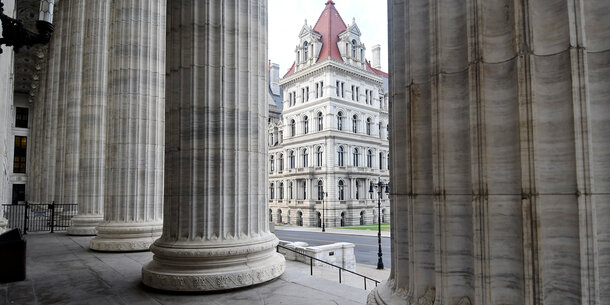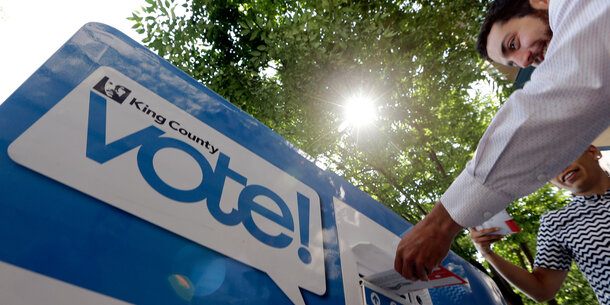Public campaign financing is a reform on the march. Recognizing it as the most powerful response to the last decade’s explosion of big money in politics, state and local governments have enacted new programs that will soon be fueling people-powered campaigns.
In New York State, candidates for statewide and legislative office will start opting in to the new small donor matching program as soon as this November. State legislators and Gov. Kathy Hochul set the program up for success earlier this week with an investment of $20.5 million in the state budget for program administration and future matching funds, a step towards securing a more equitable democracy in the state. The city of Baltimore and multiple Maryland counties will also implement their new programs soon.
These developments come on top of the other 14 states and 19 municipalities that have adopted public financing systems. Lawmakers and advocates are also pushing to bring new or strengthened programs to their communities, such as in Oregon, Arizona, and Maryland.
Public financing is a time-tested policy that exists in several forms, all of which help candidates run campaigns focused on the people they are running to represent. In small donor match systems like New York State’s, participating candidates receive a match of public funds for each eligible low-dollar contribution they raise. For example, with a matching ratio of six-to-one, a $10 contribution would get a $60 public match, making the original donation worth $70 to the candidate. Other programs offer qualifying candidates block grants or provide residents with vouchers that allow them to assign public funds to participating candidates.
In the face of bigger and bigger expenditures after the Supreme Court’s 2010 decision in Citizens United opened the floodgates to unlimited and often secret election spending, public financing is the best constitutionally permissible way to address the influence of big money. The reform has boosted the value of small contributions from everyday donors, enabling candidates to spend their time fundraising among more of the people they seek to represent, as opposed to wealthy megadonors.
Candidates have been running publicly financed campaigns for decades in states like Connecticut, Arizona, and Maine, as well as major cities, including New York City, San Francisco, and Los Angeles. These long-running programs show the reform’s adaptability over time as they maintain their benefits to candidates and small donors alike.
Here’s a closer look at how this reform has empowered everyday Americans in recent elections.
Supporting candidates to win without big money
Public financing programs help participating candidates run for office and win, even in the face of big spending by corporations and special interests. In 2020, Washington, DC, held its first city council and board of education elections with its Fair Elections Program. Candidates who opted in to the program tended to outraise and outspend — and enjoy greater electoral success — than their privately financed counterparts, even without accepting large campaign contributions from wealthy donors, corporations, or PACs.
Programs in New York City and Portland, Oregon, have also given candidates a path to success without wealthy donors. In Portland’s first elections with public financing, candidates raised a far higher percentage of their funds from individuals rather than from special interest groups, and two-thirds of competitive candidates opted in to the public financing program.
New York State Attorney General Letitia James, who ran under the New York City program before taking state office, told the Brennan Center, “I wouldn’t be where I am today if not for public financing. I come from a hardworking family, but not a wealthy one. When I first ran for office, I did not know millionaires, and I did not know those with deep pockets.”
Increasing small-donor and constituent involvement
Programs encourage new and more diverse donors to give, boosting the civic participation our democracy needs to flourish. In 2018, during the first cycle of the matching program in Berkeley, California, the average contribution size decreased by 60 percent from the previous election. Participating campaigns also saw more donor participation across the city, not just in the wealthiest and whitest zip codes. Likewise, since its 2017 debut, Seattle’s voucher program has disrupted the status quo, bringing more young people, people of color, and working people into the political process.
More recently, during the first election under the program in Washington, DC, publicly financed candidates received over twice as many individual contributions on average as nonparticipating candidates did in 2020. Fair Elections candidates also received much smaller contributions on average and engaged more new donors and district residents than their privately financed counterparts. The zip code with the most contributions has one of the lowest median incomes in the district and encompasses some of its most diverse neighborhoods.
Portland saw similar benefits. Participating mayoral candidates received, on average, nine times more individual contributions than their nonparticipating counterparts. Publicly financed candidates also received an average contribution of $81, 15 times smaller than the average contribution in 2016. A majority of small donors had never given to a candidate for city office before. Contributors were also more evenly spread across the city, reducing the disparity between lower-income neighborhoods and wealthier areas in the city.
Breaking down barriers to entry
Public financing programs open doors to candidates who are women, people of color, members of the LGBTQ+ community, and working individuals. As Arizona State Sen. Victoria Steele put it, “As a Native American woman — I am Seneca and Mingo — public financing gave me an advantage. It’s really hard for anybody to raise money to run for office, but women are generally more disadvantaged in raising money for races.” Public funding, though not sufficient on its own, helps counter this systemic discrimination.
When Washington, DC, implemented public financing, the total number of women running for city council and board of education increased from 12 to 16, while the total number of candidates of color increased from 14 to 38. Half of the individuals elected to the council in 2020 were publicly financed candidates, all of whom were people of color. Voters also elected a majority female council for the first time in decades.
New York City’s last city council elections saw similar trends. Women and people of color who won seats or were competitive in the primaries raised as much, on average, as their white and male counterparts and relied to similar degrees on small donations and public matching funds. Women increased their representation on the city council from 27 percent to 61 percent. People of color, who make up 68 percent of city residents, increased their representation from 51 percent to 67 percent. Women of color more than doubled their council seats.
Better representation goes hand in hand with greater responsiveness to constituents’ needs. Publicly financed candidates report that their campaign trail conversations with constituents inform the bills they introduce once elected. New York City Public Advocate Jumaane Williams shared that, with a match, elected officials can raise money while they “speak to people who give $5 and $10 — and that’s all they can afford.”
• • •
The enactment and improvement of more programs will only add to the body of research demonstrating public financing’s benefits for candidates and constituents alike. For now, the policy stands as one of the best tools we have for combatting big money in politics and amplifying the voices of everyday Americans.




